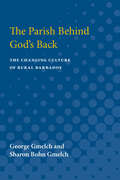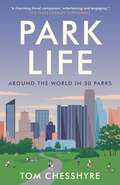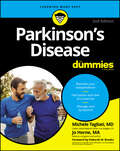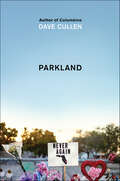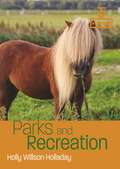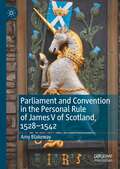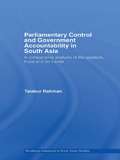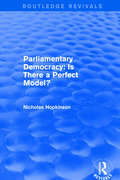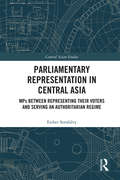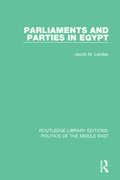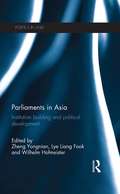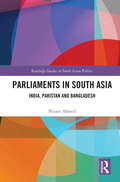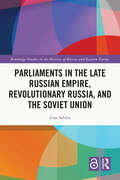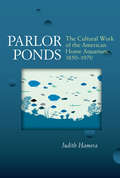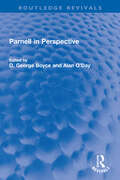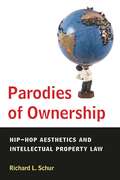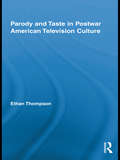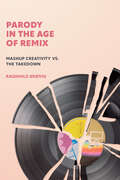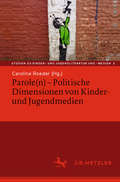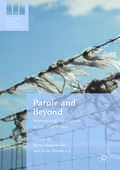- Table View
- List View
Parisar Adyayan class 3 - Maharashtra Board: परिसर अध्ययन ३रीं कक्षा - महाराष्ट्र बोर्ड
by Maharashtra Rajya Pathyapustak Nirmiti Va Abhysakram Sanshodhan Mandal Pune"परिसर अध्ययन - तीसरी कक्षा (हिंदी माध्यम)" पुस्तक छात्रों को उनके आसपास के प्राकृतिक, सामाजिक और सांस्कृतिक परिवेश की जानकारी देने के लिए बनाई गई है। यह पाठ्यपुस्तक महाराष्ट्र राज्य पाठ्यपुस्तक निर्मिति एवं अभ्यासक्रम संशोधन मंडल द्वारा प्रकाशित की गई है और इसमें प्राथमिक शिक्षा के अनुरूप सरल भाषा में विषयों को प्रस्तुत किया गया है। पुस्तक में भारत के संविधान, मूल कर्तव्य, पर्यावरण अध्ययन, जलवायु परिवर्तन, प्राकृतिक संसाधन, वन्य जीवन, मानव समुदाय, परिवहन एवं संचार, स्वास्थ्य एवं स्वच्छता जैसे महत्वपूर्ण विषयों को शामिल किया गया है। इसमें छात्रों को व्यावहारिक ज्ञान देने के लिए चित्र, गतिविधियाँ, पर्यवेक्षण, प्रश्नोत्तर और स्व-अध्ययन सामग्री दी गई है। इसके माध्यम से बच्चों को पर्यावरण की रक्षा, सामाजिक समरसता, विज्ञान एवं प्रौद्योगिकी की समझ, और नागरिक जिम्मेदारियों के बारे में जागरूक किया जाता है। शिक्षकों और अभिभावकों के मार्गदर्शन से यह पुस्तक बच्चों में ज्ञान अर्जन, अन्वेषण और विश्लेषणात्मक सोच को विकसित करने में सहायक सिद्ध होती है। यह पुस्तक न केवल पाठ्यक्रम का हिस्सा है, बल्कि बच्चों को जिम्मेदार नागरिक बनने की दिशा में भी प्रेरित करती है।
Parish behind God's Back: The Changing Culture of Rural Barbados
by George Gmelch Sharon Bohm GmelchOne of the first things any visitor to Barbados notices is Barbadian youths wearing baseball caps and T-shirts sporting the logos of North American teams; and these days, one is more likely to find an American sitcom on television than a Caribbean program. The Parish behind God's Back describes the social fabric and everyday life of one rural parish on the island, St. Lucy, including its many links to the outside world. It is a contemporary ethnography of the local that takes into account the enormous influence of global factors such as tourism, television, foreign travel, and return migrants. Written with students in mind, the book contains several unique features. Each chapter blends descriptions of Barbadian culture with comparisons to North America; throughout, the authors include tales of not only their own fieldwork experiences but those of their undergraduate students; and personal narratives are emphasized to engage interest in individuals. This highly readable and thought-provoking account should appeal to general readers with an interest in the Caribbean as well as to students of anthropology. George Gmelch is Professor and Chair, Department of Anthropology, Union College. Sharon Bohn Gmelch is Professor of Anthropology and Director of Women's Studies, Union College.
Park Cruising: What Happens When We Wander Off the Path
by Marcus McCannAn intimate look at one of culture’s most enduring taboos: public sex. Park Cruising takes a long look at the men who cruise for sex in urban parks. Human rights lawyer Marcus McCann uses park cruising as a point of departure for discussions of consent, empathy, public health, municipal planning, and our relationship to strangers. Prompted by his work opposing a police sting in a suburban park, McCann’s ruminations go beyond targeted enforcement and police indifference to violence to examine cruising as a type of world-building. The result is a series of insightful and poetic walks through history, law, literature, and popular representations of cruising in search of the social value of sex. What McCann ultimately reveals is a world of connection, care, and unexpected lessons about the value of pleasure.
Park Life: Around the World in 50 Parks
by Tom ChesshyreIf the pandemic has taught us one thing, it's that people love parks Wherever we are in the world, urban parks are places where we can find calm amid the chaos. With fondness and humour, travel writer Tom Chesshyre recalls 50 of his favourite urban parks from across the world, in a love letter to the green escapes that bring us joy in our cities.
Parkinson's Disease For Dummies
by Michele Tagliati Jo HorneMaintain a take-charge attitude and live your life to the fullest with Parkinson's Whether the diagnosis is yours or that of a loved one, Parkinson's Disease for Dummies contains everything you need to know about living with this disease. This book is an easy-to-understand, straightforward, and sometimes humorous guide that offers proven techniques for coping with daily issues, finding the right doctors, and providing care as the disease progresses. This user-friendly guide helps you navigate you through the important steps toward taking charge of your condition. You aren't alone—inside, you'll discover proven coping skills and first-hand advice, along with practical tools that will help you navigate the treatment journey. In classic, compassionate Dummies style, Parkinson's Disease For Dummies will answer all your questions, and guide you through the process of finding your own answers as well. Keep your mind sharp, stay in shape, and keep your stress under control Life a full and satisfying life after a Parkinson's diagnosis Get the most current information on Parkinson's medications and treatments Learn the best ways to support loved ones living with Parkinson's With updates on the latest in alternative treatments, dementia, and young onset PD, Parkinson's Disease for Dummies is here to show you how you can keep a positive attitude and lead an active, productive life.
Parkland: Birth of a Movement
by Dave CullenThe New York Times bestseller about the extraordinary young survivors who took on the gun lobby: “One of the most uplifting books you will read all year.” —The Washington PostBack in 1999, Dave Cullen was among the first to arrive at Columbine High, even before most of the SWAT teams went in. While writing his acclaimed account of the tragedy, he suffered two bouts of secondary PTSD. He covered all the later tragedies from a distance, working with a cadre of experts cultivated from academia and the FBI, but swore he would never return to the scene of a ghastly crime.But in 2018, Cullen went to Marjory Stoneman Douglas High School because something radically different was happening. After nearly twenty years witnessing the mass shooting epidemic escalate, he was stunned and awed by the courage, anger, and conviction of the high school’s students. Refusing to allow adults and the media to shape their story, these remarkable adolescents took control—pushing back against the NRA and feckless Congressional leaders, organizing the massive March for Our Lives demonstration, and inspiring millions to join their grassroots #neveragain movement. They used their grief as a catalyst for change, and galvanized a nation. Cullen unfolds the story of Parkland through the voices of key participants. Instead of taking us into the mind of the killer, he takes us into the hearts of the Douglas students as they cope with the concerns of high school students everywhere—awaiting college acceptance letters, studying for midterms, competing against their athletic rivals, putting together the yearbook, staging the musical Spring Awakening, enjoying prom—while moving forward from a horrific event that has altered them forever.Deeply researched and beautifully told, Parkland is “a moving petition to America that it not look away from the catastrophes at Columbine, Sandy Hook, Virginia Tech, and, yes, Parkland. It succeeds as an in-depth report about the ‘generational campaign’ in the aftermath of the Parkland tragedy, a bi-partisan movement advocating serious gun reform” (Atlanta Journal-Constitution).“[A] page-turner. . . . Both realistic and optimistic, this insightful and compassionate chronicle is a fitting testament to a new chapter in American responses to mass shootings.” —Publishers Weekly (starred review)
Parks and Recreation (TV Milestones Series)
by Holly Willson HolladayAn homage to Parks and Recreation (2009–15) and an exploration of how the show evolved as a traditional network sitcom in a post-network era. This deep dive into the series highlights the new norm of digital fandom, where social media has become a means for fans to engage with the series beyond its runtime. While the media landscape evolved, so did American sociopolitical discourse; Holladay examines the series contained entirely within Barack Obama’s presidency as it reflects the role of politics in American life on a micro scale. The series follows the career and personal life of Leslie Knope (Amy Poehler), a self-possessed, midlevel bureaucrat whose initial ideology reflects the optimistic tone of politics ushered in with Obama’s campaign and early presidency. Throughout its run, Parks and Recreation engaged with political debates simmering in American culture, offering a humorous ripped-from-the-headlines take on issues such as same-sex marriage, distrust of politicians, government shutdowns, and corporate bailouts Through compelling analysis, Holladay untangles representations of women and BIPOC in the series as they engage with contemporary discourse surrounding media and identity politics.
Parliament and Convention in the Personal Rule of James V of Scotland, 1528–1542
by Amy BlakewayThis book, based on a fresh understanding of Scottish governmental records rooted in extensive archival research, offers the first study of these important institutions in a period of revived royal authority. The regime which emerges from these records is one which understood the power of consultation, adroitly using a range of groups from full parliaments to conventions of specialists and experts selected to deal with the matter in hand. Policies were crafted through not one single meeting but several types of gathering, ranging from small groups when secrecy was of the essence or complex details required to be hammered out, to elaborate large gatherings when the regime employed a performative strategy to disseminate information or legitimise its policies. Still more impressively, much of this was managed in the King’s absence – James remained at a distance from many of these gatherings, relying on key officials such as the Chancellor or Clerk Register to relay counsel and the royal will. This emphasis on specialised, frequent consultation reflects concurrent developments in the council, whilst relocating debate surrounding the development of state and administrative structures in Scotland traditionally located in the late sixteenth-century into the 1530s. In tackling the development of parliament in Scotland and placing it in its proper context amongst many different forms of consultative meeting this book also speaks to subjects of European-wide concern: how far early modern Parliaments were used to impose or resist religious change, the pace of state formation, monarchical power and relations between monarchs and their subjects.
Parliamentary Control and Government Accountability in South Asia: A Comparative Analysis of Bangladesh, India and Sri Lanka (Routledge Advances in South Asian Studies)
by Taiabur RahmanParliaments or legislatures are the keystone of democratic governance and they are critical in securing government accountability. This book presents a comparative analysis of the role of parliamentary committees in securing government accountability in the three largest and most important functioning democracies in South Asia: Bangladesh, India and Sri Lanka. The author compares the nascent democracy of Bangladesh with the stable and vibrant democratic system of India since its independence from the British in 1947 and Sri Lanka's longstanding and established democracy. He argues that in each country, parliament has been able to survive and perform the key parliamentary tasks of representation, legislation, oversight of the executive, conflict resolution and regime maintenance; concluding that parliamentary committees in Bangladesh, India and Sri Lanka do not perform as successfully as their counterparts in the Western world in controlling the government and holding it to account; however, their role in securing government accountability is not irrelevant. Parliamentary Control and Government Accountability in South Asia will be a useful reference for studying third world parliaments in particular.
Parliamentary Democracy: Is There a Perfect Model?
by Nicholas HopkinsonThis title was first published in 2001. With the collapse of Communism in Central and Eastern Europe, the legitimacy of one-party, and often one-person rule in other parts of the world has been fundamentally challenged. It appears that for the first time parliamentary democracy has become the universally accepted model to adopt or to be perfected. Newer democracies have started to build the institutions and capacity necessary to sustain democracy, while established democracies continue to refine their democracy, sometimes introducing full-scale reforms. This book examines whether elements of the perfect democracy can be identified and how democratic structures and practices can be improved.
Parliamentary Enclosure in England: An Introduction to its Causes, Incidence and Impact, 1750-1850
by Gordon E MingayEnclosure transformed the old open fields and common lands of England to create the modern rural landscape. It changed forever the life of many villages, but provided food for a rapidly rising population. Its methods and consequences were controversial - many rural poor lost their access to land - and the subject is still a cause of dispute. Gordon Mingay's authoritative survey guides the reader through the complexities of the topic. He describes the processes by which land was reorganised and analyses the impact of enclosure regionally. Throughout he stresses the extent of local variation which make the subject so complex.
Parliamentary Representation in Central Asia: MPs Between Representing Their Voters and Serving an Authoritarian Regime (Central Asian Studies)
by Esther SomfalvyThis book explores the nature of parliamentary representation within the autocratic regimes of Kazakhstan and Kyrgyzstan. It argues that although many parliaments are elected under flawed or non-competitive elections, autocratic governments are nevertheless aware of the need to appear representative and accessible to the demands of citizens and that even limited parliaments manage to represent their voters, sometimes in ways not intended by the regime. The book examines how elites structure, manage and organize representation; how they foster the desired kind of representation; and how they limit the ways in which parliaments fulfil their representative functions. The book concludes that Kazakhstan is a more hegemonic form of autocracy and the Kyrgyz Republic a more competitive form and that the degree to which parliaments fulfil their representational functions and how much room for manoeuvre individual MPs have depends largely on how much parties control candidate selection and the daily schedule and administrative resources of parliaments.
Parliaments and Parties in Egypt (Routledge Library Editions: Politics of the Middle East #16)
by Jacob M. LandauEgypt was the first Arabic-speaking country to throw off the yoke of Turkish rule, with an attendant growth in European influence. The impact of the West was most obvious in the political-constitutional field, with the gradual adoption of Western patterns of government and political life. This book, first published in 1953, is the first work to trace the development of parliamentary institutions and political parties in Egypt and to consider the extent of Western influence on their inception, evolution and disruption. Based on both Arabic and European sources, it is a comprehensive examination of the subject, and is key to the understanding of the development of the modern Middle East.
Parliaments in Asia: Institution Building and Political Development (Politics in Asia)
by Zheng Yongnian Lye Liang Fook Wilhelm HofmeisterMuch writing on politics in Asia revolves around the themes of democracy and democratisation with a particular focus on political systems and political parties. This book, on the other hand, examines the role that parliaments – a key institution of democracy – play in East, Southeast and South Asia including Taiwan and Hong Kong. Parliaments in these locations function in a variety of historical, political and socio-economic circumstances with different implications for institution building and political development. This book examines questions like how accessible, representative, transparent, accountable and effective are parliaments? To what extent are parliaments able to hold other political actors to account or how far are they constrained by the political environment in which they operate? Going further, this book considers how new media such as the Internet and other social platforms, through providing avenues for individuals to articulate their views separate from official channels, are influencing the ways parliaments work. To stay relevant, parliamentarians need to reach out and engage these individuals in formulating, deciding and fine-tuning policies. In the information age, being a parliamentarian has become more challenging and how a parliamentarian copes with this change will shape the nature and pace of political development.
Parliaments in South Asia: India, Pakistan and Bangladesh (Routledge Studies in South Asian Politics)
by Nizam AhmedThis book explores the development, decline and resurgence of parliaments in India, Pakistan and Bangladesh. Although the three parliaments formally have a common origin and follow almost similar rules and procedures, substantial variations can be observed in their behavior. By analyzing the nature of memberships, processes of legislation and oversight of the executive, the book assesses the impact of Indian, Pakistani and Bangladeshi parliaments. In addition to identifying the ways in which different institutional actors, particularly the parliament and the judiciary, define their roles and relationships, the book investigates the role of committees and the significance and effect of female legislators. While showing that the parliament in India has had a steady growth since its inception, notwithstanding the allegation that it has declined in recent years, the author also demonstrates the differential performance of the parliaments in Bangladesh and Pakistan. In particular, the parliament in Pakistan is shown to likely be able to upgrade its status from a ‘minimal’ to at least a ‘marginal’ legislature, while the Bangladesh parliament risks becoming a ‘minimal’ legislature. A valuable resource to use when comparing strategies and outcomes of postcolonial developments in the operation of parliaments, this book will be of interest to academics in the field of political and economic development, governance and South Asian Studies.
Parliaments in the Late Russian Empire, Revolutionary Russia, and the Soviet Union (Routledge Studies in the History of Russia and Eastern Europe)
by Ivan SablinThis book examines the meanings that were attached to the terms “parliament” and “parliamentarism” in the different historical and discursive contexts of the late Russian Empire, revolutionary and Soviet Russia, and the Soviet Union. It discusses those institutions referred to as parliaments by contemporaries, gives special attention to their functions, and traces the broader debates on parliamentarism within Russia and the Soviet Union, in Russian émigré circles, and among foreign observers. It highlights that only the late imperial and perestroika assemblies can be considered legislative institutions that expressed dissensus but argues that other assemblies, often referred to as “rubber-stamp” parliaments due to their lack of legislative competence and influence over other authorities, should not be dismissed. The Supreme Soviet, for instance, provided an integrative function binding society and elites in a top-down manner, while its deputies engaged in information acquisition and state micromanagement through interactions with their constituents. It also played an important role in interparliamentary relations and, as one of the first institutions of nominal parliamentarism in an autocratic single-party regime, of which there were many in the twentieth century, served as a model for numerous state socialist regimes. By addressing the role of parliaments in reassembling imperial spaces through political representation and the functions of nominal legislative institutions, the book explores the contribution of Russian and Soviet assemblies to global political modernity.
Parlor Ponds: The Cultural Work of the American Home Aquarium, 1850-1970
by Judith HameraParlor Ponds: The Cultural Work of the American Home Aquarium, 1850–1970examines the myriad cultural meanings of the American home aquarium during the nineteenth and twentieth centuries and argues that the home aquarium provided its enthusiasts with a potent tool for managing the challenges of historical change, from urbanization to globalization. The tank could be a window to an alien world, a theater for domestic melodrama, or a vehicle in a fantastical undersea journey. Its residents were seen as inscrutable and wholly disposable “its,” as deeply loved and charismatic individuals, and as alter egos by aquarists themselves. Parlor Pondsfills a gap in the growing field of animal studies by showing that the tank is an emblematic product of modernity, one using elements of exploration, technology, science, and a commitment to rigorous observation to contain anxieties spawned by industrialization, urbanization, changing gender roles, and imperial entanglements. Judith Hamera engages advertisements, images, memoirs, public aquarium programs, and enthusiast publications to show how the history of the aquarium illuminates complex cultural attitudes toward nature and domestication, science and religion, gender and alterity, and national conquest and environmental stewardship with an emphasis on the ways it illuminates American public discourse on colonial and postcolonial expansion.
Parlour Games and the Public Life of Women in Renaissance Italy
by George W. McclureConfined by behavioural norms and professional restrictions, women in Renaissance Italy found a welcome escape in an alternative world of play. This book examines the role of games of wit in the social and cultural experience of patrician women from the early sixteenth to the early eighteenth century.Beneath the frivolous exterior of such games as occasions for idle banter, flirtation, and seduction, there often lay a lively contest for power and agency, and the opportunity for conventional women to demonstrate their intellect, to achieve a public identity, and even to model new behaviour and institutions in the non-ludic world. By tapping into the records and cultural artifacts of these games, George McClure recovers a realm of female fame that has largely escaped the notice of modern historians, and in so doing, reveals a cohort of spirited, intellectual women outside of the courts.
Parnell in Perspective (Routledge Revivals)
by Alan O’Day D. George BoyceFirst published in 1991, Parnell in Perspective is a collection of essays exploring the ideas and political style of Charles Stewart Parnell. Divided into two parts, the book explores Parnell’s career in detail and investigates the parliamentary and personal qualities that led to his reputation as ‘The Uncrowned King of Ireland’. It will appeal to those with an interest in Irish and British political and social history.
Parodies of Ownership: Hip-Hop Aesthetics and Intellectual Property Law
by Richard L. SchurWhat is the relationship between hip-hop and African American culture in the post--Civil Rights era? Does hip-hop share a criticism of American culture or stand as an isolated and unique phenomenon? How have African American texts responded to the increasing role intellectual property law plays in regulating images, sounds, words, and logos? Parodies of Ownership examines how contemporary African American writers, artists, and musicians have developed an artistic form that Schur terms "hip-hop aesthetics." This book offers an in-depth examination of a wide range of contemporary African American painters and writers, including Anna Deavere Smith, Toni Morrison, Adrian Piper, Colson Whitehead, Michael Ray Charles, Alice Randall, and Fred Wilson. Their absence from conversations about African American culture has caused a misunderstanding about the nature of contemporary cultural issues and resulted in neglect of their innovative responses to the post--Civil Rights era. By considering their work as a cross-disciplinary and specifically African American cultural movement, Schur shows how a new paradigm for artistic creation has developed. Parodies of Ownership offers a broad analysis of post--Civil Rights era culture and provides the necessary context for understanding contemporary debates within American studies, African American studies, intellectual property law, African American literature, art history, and hip-hop studies. Weaving together law, literature, art, and music, Schur deftly clarifies the conceptual issues that unify contemporary African American culture, empowering this generation of artists, writers, and musicians to criticize how racism continues to affect our country.
Parody and Taste in Postwar American Television Culture (Routledge Advances in Television Studies)
by Ethan ThompsonIn this original study, Thompson explores the complicated relationships between Americans and television during the 1950s, as seen and effected through popular humor. Parody and Taste in Postwar American Television Culture documents how Americans grew accustomed to understanding politics, current events, and popular culture through comedy that is simultaneously critical, commercial, and funny. Along with the rapid growth of television in the 1950s, an explosion of satire and parody took place across a wide field of American culture—in magazines, comic books, film, comedy albums, and on television itself. Taken together, these case studies don’t just analyze and theorize the production and consumption of parody and television, but force us to revisit and revise our notions of postwar "consensus" culture as well.
Parody in the Age of Remix: Mashup Creativity vs. the Takedown
by Ragnhild BrøvigThe art of mashup music, its roots in parody, and its social and legal implications.Parody needn&’t recognize copyright—but does an algorithm recognize parody? The ever-increasing popularity of remix culture and mashup music, where parody is invariably at play, presents a conundrum for internet platforms, with their extensive automatic, algorithmic policing of content. Taking a wide-ranging look at mashup music—the creative and technical considerations that go into making it; the experience of play, humor, enlightenment, and beauty it affords; and the social and legal issues it presents—Parody in the Age of Remix offers a pointed critique of how society balances the act of regulating art with the act of preserving it.In several jurisdictions, national and international, parody is exempted from copyright laws. Ragnhild Brøvig contends that mashups should be understood as a form of parody, and thus be protected from removal from hosting platforms. Nonetheless, current copyright-related content-moderation regimes, relying on algorithmic detection and automated decision making, frequently eliminate what might otherwise be deemed gray-area content—to the detriment of human listeners and, especially, artists. Given the inaccuracy of takedowns, Parody in the Age of Remix makes a persuasive argument in favor of greater protection for remix creativity in the future—but it also suggests that the content-moderation challenges facing mashup producers and other remixers are symptomatic of larger societal issues.
Parole (Studien zu Kinder- und Jugendliteratur und -medien #2)
by Caroline RoederAuch 50 Jahre nach 1968 sind die Kinder- und Jugendliteratur und -medien in vielfältiger Weise in politische und ideologische Horizonte eingespannt. Angesichts der aktuellen ‚Wiederkehr’ des Ideologischen und insbesondere nach dem kulturwissenschaftlichen Turn in den Geisteswissenschaften stellen sich die Fragen nach politischen und ideologischen Einschreibungen unter neuer Perspektive. Der Band versammelt 25 Beiträge, die das Feld historisch, kulturwissenschaftlich und systemtheoretisch vermessen. Dabei werden literaturästhetische Aspekte ebenso thematisiert wie pädagogische Diskurse oder interdisziplinäre Vernetzungen.
Parole and Beyond
by Ioan Durnescu Ruth ArmstrongThis book aims provides an assessment of contemporary international knowledge about the experiences of life after release from prison. For over 100 years people leaving prison have been supervised by probation services, but little has been written about how those who are supervised experience this process, or how this process influences experiences post-release. Research suggests that the success or failure of supervision in terms of reoffending may be related to how it is experienced, but little has been written about how supervision interacts with these experiences. Despite this lack of grounded knowledge, post-prison supervision continues to grow internationally. This book addresses issues relating to life after release through providing a vision of contemporary life after prison in different social and economic climates from those who are the subjects of this growing and changing form of penal power. An engaging and timely study, this book will be of particular interest to scholars of criminal justice and punishment.
Parole on Probation: Parole Decision-Making, Public Opinion and Public Confidence (Palgrave Socio-Legal Studies)
by Lorana Bartels Arie Freiberg Robin Fitzgerald Shannon DoddThis book explores key issues in relation to parole and public opinion, including the relevance of public opinion to parole boards decision-making and strategies for increasing public confidence in parole. It presents the findings of semi-structured interviews with 80 members of parole authorities in 12 jurisdictions, across Australia, New Zealand, Canada and Scotland. Unlike judicial processes, which are open to the public, there is little awareness of and research on the work of parole authorities. This book therefore shines a light on a little-understood, but hotly-contested, aspect of the criminal justice system. Specifically, it explores differences across the study jurisdictions and considers how parole authorities in the four study countries view public attitudes, as well as the role of the media in shaping public attitudes towards parole. The book also considers whether public reaction matters for parole board decision-making and the interplay between informing the public and offender reintegration. It explores a range of strategies which may improve public confidence in parole and therefore the criminal justice system more broadly. This includes consideration of the value, definition and possibility of public confidence. The authors then discuss both passive forms, such as parole authority websites, publication of decisions and social media, before examining active forms of engagement, including an information/liaison officer, roadshows and community fora.

